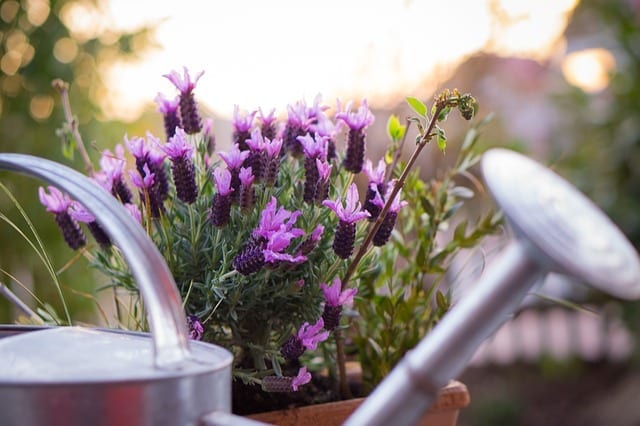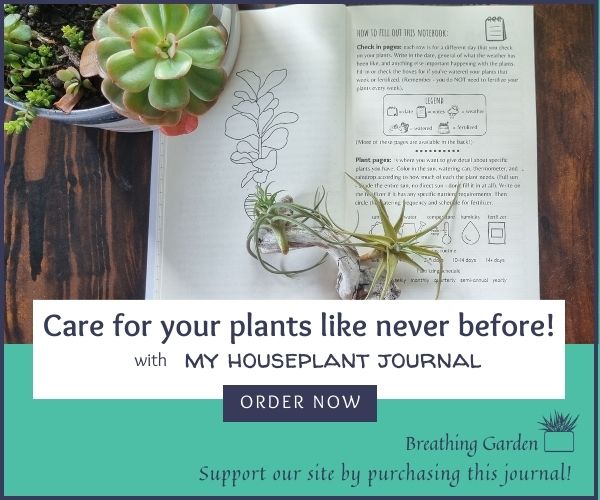Lavender, a large, leafy perennial native to Europe and the Mediterranean, is a popular garden plant thanks to its hardiness and beautiful, small purple flowers. Aside from its attractive appearance, most people grow lavender because it has a light, soothing aroma.
*This post may include affiliate links. When you purchase items from these links, we will receive a small commission, at no extra cost to you, to help support this website. Thank you for your support! Read more ->
The flowers can be dried and used in teas or sachets. Because it smells so wonderful, it’s great to have an indoor lavender plant, rather than just in the garden.
But can lavender grow inside? Yes! It can, under the right conditions. Growing lavender indoors can be a bit tricky, but understanding what the plant needs to thrive can help you grow a full, healthy indoor lavender plant.

Related: Lavender Companion Plants, French Lavender, Spanish Lavender, Grow Mint Indoors
Is Lavender an Outdoor or Indoor Plant?
Before we talk about how to grow a lavender plant inside, let’s talk about is lavender an outdoor or indoor plant? Although lavender is traditionally an outdoor plant, it can grow quite well indoors, and in a more temperate indoor climate, it will often stay green and lush all year round.
Lavender can grow to be very large bushes, which is probably why it’s thought of as an outdoor plant. These need a lot of space for roots to grow, and wouldn’t do very well in a pot.
But there are some smaller varieties that will thrive indoors! Regardless of if you’re growing the lavender inside or out, if it’s given enough sunlight, your plant will have beautiful dark purple flowers during the summer.
Why Grow Lavender Indoors?
The gentle scent of lavender can delicately perfume a room, so why not place a small lavender plant near your bed, at your desk, or in your kitchen?
When choosing a lavender plant to grow indoors, try to look for a smaller variety, such as Canary Island lavender, or English lavender. These varieties generally adapt better to life inside.
If you want a larger indoor lavender plant, you could choose the Spanish Lavender. While still a large variety, it does fairly well in pots. (Read more about Spanish lavender here).
How to Keep an Indoor Lavender Plant Healthy
Light Needs
The biggest issue when it comes to growing lavender indoors is light. To remain full and green and produce abundant aromatic flowers, lavender plants require a lot of direct sunlight. If you have a very bright space in your home that gets a lot of natural light, this is the perfect place for a lavender plant!
If you don’t, you may want to consider a small grow light. Not offering enough bright light is the downfall of most lavender house plants (read why lavender can’t grow in shade here).
I suggest a grow light, (this one has 4 arms so you can have multiple plants) so you can have multiple plants under the grow light
You’ll also want to rotate your plant once a week. This will help to ensure that all sides of the plant are receiving light equally, and it will encourage even growth.
One of the biggest things to consider when thinking ‘can lavender grow inside’ is if you’ve got a sunny enough spot for it, or are willing to invest in a light for your lavender.
Watering Requirements

Lavender plants can easily be overwatered, which leads to root rot, so it’s important to water carefully. Thoroughly soak the soil each time you water, but let the soil dry out before watering again. When watering lavender, you can check for when it needs to be watered again by checking the soil moisture. You can check soil moisture by inserting your finger into the soil, and the soil should be dry to about an inch down. If it’s still damp, wait a few more days before watering again. Kep reading about overwatering and underwatering lavender.
Keep in mind that if you overwater your lavender, your plant may start yellowing or wilting.
Pruning
Pruning can help you keep your lavender plant healthy, and it’s also what you’ll need to do if you want to harvest and dry any of the flowers. Try to prune lavender by cutting full branches from the plant. This will encourage new growth of leaves and flowers, rather than woody growth. You can also prune the tips of the branches, but, although this leads to fuller plants, it will also eventually decrease flower production.
If you want to make your lavender a lavender tree, you can prune it to shape! Read how to make your own lavender topiary tree here.

You can do so much with the pruned lavender as well, making scented satchels of lavender for drawers, make your own lavender oils, or lavender bath salts. You can also use it in a sage bundle for smoke cleanses, and can read more about that here!
Potting Soil
Plant your lavender in potting soil that drains well. You may want to add limestone or perlite to your potting mix to increase the soil’s draining ability. In addition, lavender likes a slightly alkaline pH. You can add crushed eggshells to the top of the soil once a month to increase the alkalinity. You can also fertilize the plant with an all-purpose fertilizer, once a year.
Looking for plants that grow well with lavender? Read here about the best lavender companion plants, that work in harmony next to the lavender.
Pot Choice
Pot size and material are also important factors to consider when growing lavender indoors. The lavender should be placed in a pot that’s only about one or two inches wider across than the roots of the lavender. This helps the lavender soak in water and won’t leave any spots where the lavender roots can’t reach. These empty spots often become waterlogged and can cause root rot later on.
Make sure to choose one that will easily fit the root ball, with some space to grow without too much extra.

You may want to consider a terracotta pot for your lavender. Terracotta pots allow for evaporation, so plants are less likely to become waterlogged or develop root rot.
Shop terracotta pots for Lavender on Amazon.
Repotting
Something that can be good to do with your lavender every year or two years especially one that’s growing indoors is to repot the plant. It doesn’t have to be in a different pot, or even necessarily different soil. Just take the lavender out of the pot, make sure it’s not getting root bound (you can always cut the roots back to maintain your lavender’s size), and break up the dirt so it doesn’t get compacted!
Convinced that lavender can grow inside and that you will have your own indoor lavender plant? We hope this has been helpful reading and has convinced you! Just remember to give it a spot with full sun, don’t overwater, and use the right size pot and you should have a happy lavender plant! If you’re worried your lavender is turning brown, find out why here.
Pin It!
Want to keep these tips for growing lavender indoors for later? Save them to Pinterest!




